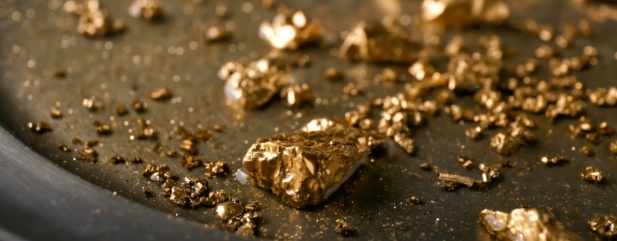Archived article
Please note that tax, investment, pension and ISA rules can change and the information and any views contained in this article may now be inaccurate.
Will gold shine again (just like it did after 2008?)

One of the most confusing features of the current market rout has been gold’s failure to confirm its status as a haven asset during times of trouble.
At the time of writing the precious metal is up by barely 1% since the start of the year and is down by 8% from the year high reached on 24 February when investors first began to sense that the full implications of the COVID-19 outbreak were much more serious than initially thought.
One common theory to explain gold’s slump is that investors are looking to meet redemptions or margin calls and the precious metal is a logical port of call, especially as many investors will have a profit to take and the gold market is relatively liquid.
This makes sense, especially as the same happened to gold when all hell broke loose in the financial markets in 2008.
Back to the future
As the recession deepened and stock markets tumbled, gold was dragged down as professional and private investors alike had to meet margin calls, settle fund redemptions or simply rustle up ready cash. Gold had surged from its 2001 lows in the $250-to-$260-an-ounce range to $1,012 by March 2008.
But even though the Fed had started to slash interest rates, from 5.25% in August 2007 to 2.25% by March 2008, and the US Government had launched the $152bn Economic Stimulus Act in February 2008, the US economy – and share prices – kept tanking, as the S&P hit 1,273 on 10 March 2008, 19% down from its October 2007 high.
As US equities flirted with a bear market, gold looked like a rich source of cash, especially as there were still profits to be taken.
Gold fell 15% to $856 by mid-May 2008, rallied but then slumped to $777 on the day of Lehman Brothers’ bankruptcy in September 2008 and only bottomed at $718 in November of that year.
By this time, then treasury secretary Hank Paulson had launched the $700bn Troubled Asset Relief Program (TARP), the Fed had launched its first round of quantitative easing in November 2008 and US interest rates were heading to 0.25%.
The newly-established Obama administration then signed the $787bn American Recovery and Reinvestment Act into law in February 2009 and the combination of huge monetary stimulus and huge fiscal stimulus gave gold an equally huge boost. Investors sought a haven as the authorities fought to take control of events, whatever the cost.
Uncanny parallels
All investors know that history offers no guarantees for the future but gold’s price slump and the progressive increase in the (intended) power of central banks’ and governments’ response to the ongoing crisis both bear uncanny resemblances to 2008 – especially as the US Federal Reserve has just gone all in, declaring on Monday (23 Mar) that it would scrap the $700bn cap on its fourth round of quantitative easing and just keep going until it had to.
In the seven days to 20 March, the Fed’s balance sheet grew by $510bn, or 12%, a rate of increase only seen in autumn 2008 when it first launched QE in the wake of Lehman Brothers’ collapse.
The Fed’s move to QE-Infinity did lift gold on 23 March and the more its balance sheet expands, the more excited gold bugs may get, especially as the policy responses of the UK, Germany and others also involve increased fiscal deficits (albeit quite understandably given the extraordinary circumstances).
Digging a hole
If QE and fiscal stimulus, of various shapes and forms, prove to be enough to support the global economy, gold may stay out of favour and, ironically, remain a source of ready cash as financial markets stay unsettled.
But if more unorthodox policy is needed, and more ‘money’ is conjured out of thin air via negative interest rates, QE, helicopter money or increased government deficits, investors could yet return to the precious metal, just as they did from late 2008 to summer 2011, when gold peaked at almost $1,900 an ounce.
That also begs a question about gold miners. Gold has been weak but gold miners have really suffered. There are some suggestions that this is a knock-on effect from investors fleeing a pair of three-times-leveraged exchange-traded funds (ETFs) in the US, tracker products which offer triple the price movement of the underlying basket of assets.
This selling has in turn, it is argued, forced the product providers to liquidate holdings of the underlying shares. If this is the case, such panic can be a contrarian buy signal – but frankly everyone will be hoping that coronavirus can be contained (and then eradicated) quickly and the global economy can rebound, so gold’s perceived defensive qualities will not be required.
But that still supposes that central banks and governments withdraw the monetary and fiscal stimulus once the viral crisis passes. And looking at how central banks have kept policy loose for 11 years and are still loosening it now, that is by no means a certainty.
Important information:
These articles are provided by Shares magazine which is published by AJ Bell Media, a part of AJ Bell. Shares is not written by AJ Bell.
Shares is provided for your general information and use and is not a personal recommendation to invest. It is not intended to be relied upon by you in making or not making any investment decisions. The investments referred to in these articles will not be suitable for all investors. If in doubt please seek appropriate independent financial advice.
Investors acting on the information in these articles do so at their own risk and AJ Bell Media and its staff do not accept liability for losses suffered by investors as a result of their investment decisions.

 magazine
magazine











